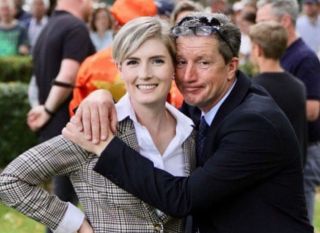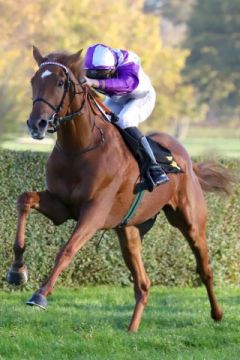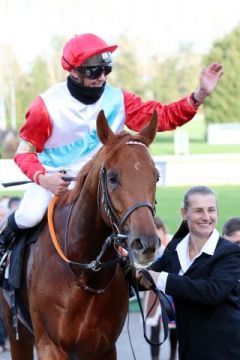Breeding & Racing in Germany
In order to be of assistance to our growing number of readers from abroad, we are with immediate effect publishing in every issue of Turf Times an English page, giving in compact form all the latest racing and breeding news from Germany in English.
When we introduced “The English page” in Turf Times a few years ago, there was no question about the author. Our English readers could not be better informed about what was happening here than by David Conolly-Smith. Born in Nottingham, the Englishman, correspondent for various British and Irish specialist newspapers, German representative of the International Racing Bureau, contact point for all active people from the island, lived in Munich and horse racing was his passion. He passed away on July 9, 2023 at the age of 83. It was his wish that Shannon Patricia Spratter should continue the English-language column in his place. He was friends with her father, the Irish-born trainer John David hillis, wo is working in Munich, and the apple doesn't fall far from the tree. Our columnist briefly introduces herself here.
 Writes the column for the English-speaking Turf Times readers: Shannon Spratter with her father, former jockey and current gallop trainer, John David Hillis. Foto: privat
Writes the column for the English-speaking Turf Times readers: Shannon Spratter with her father, former jockey and current gallop trainer, John David Hillis. Foto: privat
My name is Shannon Patricia Spratter and I was born into racing through my father, former jockey and now trainer, John David Hillis and mother, Jeanette Spratter.
Due to the recommendation of David Conolly-Smith, I have taken over his part with great enthusiasm and now write the English edition about our German racing.
When I'm not in front of the computer writing texts or pursuing my main job, I spend my time at my father's racing stable. My favourite hobby is riding races as an amateur.
Ante-post betting on British and Irish racing is very popular, and in particular at the moment when there is a lively betting market on all 28 races to be run at next month´s N.H. Festival at Cheltenham. This is not the case in Germany, where there is only one race which sttracts serious ante-post betting, the Group One Deutsches Derby at Hamburg on July 2nd – incidentally the same day as the Irish Derby at The Curragh is run. That could well have quite an impact. There is also an ante-post market on the German Oaks (Preis der Diana at Düsseldorf on August 6th), but to nowhere near the same extent.
weiterlesen »There is very little racing on at present, and hardly any in Germany, but this is the time of year when breeders and the owners of stud farms are making their plans for the upcoming breeding season. We have already this month had the Irish stallions trail, with no fewer than 140 stallions paraded, and the equivalent event in Normandy, the most important area in France. Germany´s bloodstock industry is tiny in comparison, with only about 40 active sires based in this country, but it is still impressive that 16 of them (nearly half) will be paraded at the “Züchtertreff” (“breeders´ get-together”) at Gestüt Röttgen this coming Saturday (January 28th).
There is very little happening in German racing at the moment. There are six more fixtures on Dortmund´s sand track until late March, when racing on turf begins again. In the meantime there will be plenty of German-trained runners at the Cagnes-sur-Mer meeting, which started this week, and also a few at the St. Moritz meeting on the frozen lake in February (assuming the weather allows this to take place). There have also been entries for German runners at the extremely valuable meetings in Saudi Arabia next month, as well as the Dubai Racing Carnival.
There is very little happening in German racing at the moment. There are six more fixtures on Dortmund´s sand track until late March, when racing on turf begins again. In the meantime there will be plenty of German-trained runners at the Cagnes-sur-Mer meeting, which started this week, and also a few at the St. Moritz meeting on the frozen lake in February (assuming the weather allows this to take place.) There have also been entries for German runners at the extremely valuable meetings in Saudi Arabia next month, as well as the Dubai Racing Carnival.
weiterlesen »As mentioned here last week, the number of active thoroughbred stallions standing in Germany has shrunk quite alarmingly this year, in line with the number of broodmares. There were 100 stallions standing here at the turn of the century and now only half that number. And to be brutally frank, only half of these are of really serious interest. However the three new sires for 2023 are definitely of interest. They followed a strong intake in 2022, featuring notably Japan, Alson and Windstoss, while this year`s top newcomers are Torquator Tasso, Nerik and Rubaiyat. We dealt with the 2021 Arc winner Torquator Tasso in some depth last week, now we shall have a look at Nerik and Rubaiyat.
weiterlesen »This is a very quiet time of year for German racing. We have just two days´ racing in Germany in January, both on Dortmund´s sand track, and another two more at Dortmund in February. There is then racing on three successive Sundays in March, followed by the first turf fixture, at Düsseldorf on March 28th. There is therefore no racing at all on most of the weeks in the immediate future. This is to a certain extent a reflection of the fact that the industry has shrunk quite alarmingly this century; there are now only about 2,000 horses in training, compared to well over 3,000 just 20 years ago. To a certain extent this is also due to the fact that the only other winter track, at Neuss and founded in 1875, closed down three years ago. This has also impacted on the breeding situation.
weiterlesen »There are only two more race days left in Germany this year, at Mülheim on turf (weather permitting) on Boxing Day and on New Year´s Eve on Dortmund´s sand track, and from then on Dortmund has a monopoly until the end of March. It is therefore an appropriate time to look back at the events of 2022, a difficult year in view of the continuing covid-19 pandemic and the Russian invasion of Ukraine, which caused massive problems, not only for the world of racing. However the German racing and breeding industries held up well, with crowds and betting turnover back to near 2019 levels, and it must be said that the level of German form, and in particular the top mile and a half races, has held up really well.
weiterlesen »There was racing on turf at Baden-Baden last Saturday, but from now on we are only going to have racing on the sand track at Dortmund for the next three months. The sole exception is the traditional Boxing Day fixture at Mülheim, but there must be a slight doubt about that as winter seems to have arrived and it has now turned very cold. Dortmund´s winter meeting begins this Sunday and there are in all ten days scheduled: New Year´s Eve, followed by two days in January, two more in February and four in March, almost all on Sunday with a very early start. This means that there are several weeks in January and February with no racing at all in Germany. This is mainly due to the fact that the other all-weather track, in Neuss, is now closed and extremely unlikely ever to reopen. Racing on turf resumes in April with the first group race on the 16th, the Kalkmann Frühjahrsmeile at Düsseldorf.
weiterlesen »Sadly the optimistic predictions that the European challengers, and in particular German hope Tünnes could come out on top in last weekend´s Japan Cup proved well wide of the mark. The French-trained runners finished fifth, sixth and thirteenth, while Tünnes was a disappointiung ninth in the field of 18. The 3yo from the Cologne stable of Peter Schiergen appeared rather agitated at the start, playing up for quite a while and then started very slowly. He was almost last as the field swung into the straight, where he was brought to the wide outside. There he had a clear run while those towards the inside were busy getting in each others´ way, but it hardly helped. He showed very little of the expected acceleration, but stayed on past beaten horses, finishing about 6 ½ lengths behind the winner.
weiterlesen »The season is almost at an end, and the last black type race of 2022 in Germany was run last Sunday in Munich, the Isfahan Grosser Münchener Herbstpreis, a listed race for 3yo´s and up over 2200 metres. This looked a very open affair on paper, with three foreign-trained runners, but punters were in no doubt: Gestüt Ravensberg´s homebred Wiesentau (Mukhadram) was backed down to 6-5 favouritism and won accordingly. He is trained by Andreas Wöhler on the traditional Ravensberg estate in Gütersloh, so it was a fitting result, especially as Wöhler´s other runner, Team Valor´s Lajoscha (Gleneagles) finished well to grab second place on the line. That was a decent performance but he was never going to be a danger to the winner, who led a long way out and won as he pleased. The winning margin of 3 lengths in no way reflects his superiority here.
weiterlesen »The official champion trainer in Germany is the one who wins the most races, not, as is the case in most other countries, the trainer who wins the most prize-money. In our opinion the German method is wrong; it is the trainer´s job to place his horses with such skill that they win money for their owner, and the more money, the better. Here a trainer who wins 50 low level handicaps is seen to be more successful than a trainer who wins a Group One race. The trainers themselves seem to want it this way, but we do not agree.
weiterlesen »Small fields have been a regular feature of top level racing in Europe this year. Quite a few of the best races have had five runner or less, e.g. the King George at Ascot and the Grosser Preis von Baden. This is not only bad news for the racecourse, but also makes the likelihood of a false-run race much more likely, as we saw at Baden-Baden. This can be avoided by the use of a pacemaker Aidan O´Brien is however one of the few trainers to adopt this tactic on a regular basis – or of course one can force the pace oneself. This does not always work out, but certainly worked well last Sunday at Munich, where there were only five runners in the Grosser Allianz-Preis von Bayern, the final Group One race of the 2022 season, and the hot favourite Tünnes (Guiliani) made all the running.
weiterlesen »- « erste Seite
- ‹ vorherige Seite
- …
- 2
- 3
- 4
- 5
- 6
- 7
- 8
- 9
- 10
- …
- nächste Seite ›
- letzte Seite »











